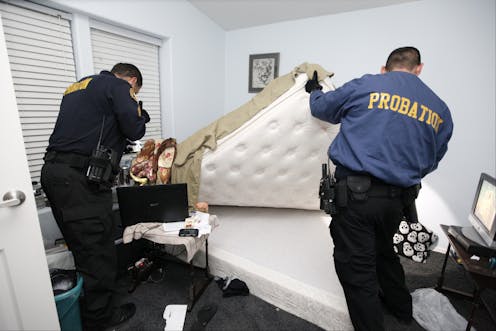Parole and probation have grown far beyond resources allocated to support them
- Written by Vincent Schiraldi, Co-Director, Columbia University Justice Lab, Senior Research Scientist, Columbia School of Social Work, Columbia University

Today, there are twice as many people supervised on parole or probation as are incarcerated in the U.S.
Parole is a period of being supervised in the community following early release from prison for following the rules. Probation is a period of community supervision ordered by courts as a punishment for a criminal offense. Together, they are often called “community corrections[1].”
I was commissioner of New York City Probation from 2010 to 2014, and research I co-authored in 2018 with 20 fellow probation and parole officials found that the number of people in community corrections has grown four-fold[2] since 1980. The number peaked in 2007 at 5.1 million Americans. In 2016 it was 4.5 million people.
This is unique internationally[3], as well as historically. Probation and parole were originally meant to serve as alternatives to prison. Instead, they have grown alongside a five-fold increase in incarceration[4] between 1980 and 2009.
On Dec. 31, 2016, the most recent date for which data is available, there were roughly 2.2 million people incarcerated in prisons and jails throughout the U.S. Add that to the 4.5 million people being supervised in the community by a parole or probation agency, and 1 in 38 adults[5] under some form of correctional supervision.
Community corrections has turned into an add-on, rather than a relief valve, to the mass incarceration dilemma in the U.S.
Too big to succeed?
Parole and probation place conditions on people, depriving them of liberty and often serving as a trip-wire for being sent back to prison. Failing, for example[6], to “work dilligently as directed by your probation officer,” or associating with persons of “disreputable or harmful character” can land people under community supervision behind bars.
Thousands of probation and parole officers supervise nearly 5 million people across the U.S. However, as the number of people under community corrections has swelled, resources for officers have lagged. While twice as many people are supervised in the community as are incarcerated, 9 out of 10 correctional dollars[7] is funneled to prisons according to a report from 2009, the most recent year with available data.
What was designed as a project to assist people at the individual level reintegrate into their communities has become a ritual in compliance. For example, last year, Philadelphia rap artist Meek Mill[8] was sentenced to two to four years in prison for a technical probation violation. He was arrested for a traffic offense and a fight in an airport, which was later dismissed.
For offenders, the “carrot” of rehabilitation has waned. The threat of being sent back to prison for technical violations, like missing an appointment or drug use – has remained. With rising caseloads, probation and parole officers often feel compelled to rely on sending people back to prison to deal with even trivial misbehavior.
In 2012, a study found that 4 out of 10 people[9] incarcerated in the U.S. were on probation or parole at the time when they were arrested and taken back into prison, many for technical violations.
Where I work in New York, for every 10 people who finished state parole successfully in 2015, 9 were reincarcerated[10] – the ninth worst rate in the country. More than one-third of people[11] entering New York’s prisons annually are returning because of parole violations.
Vulnerable and returning home
Probation and parole are not evenly distributed across the population. It primarily affects young African-American and Latino men in low-income communities. One in 12 African-American males[12] is under community supervision, as is nearly 1 in 5 young African-American males[13] without a high school education. In New York City, there are 12.4 times as many[14] African-Americans per capita in city jails for a parole violation than whites.
Less is more
In 2017, every major community corrections association in the U.S., along with 45 elected or appointed prosecutors and 35 probation and parole officials as well as myself wrote in a statement[15]: “Designed originally as an alternative to incarceration, community corrections has become a significant contributor to mass incarceration” that should be downsized while reinvesting the savings in “improving community based services and supports for people under supervision.”
New York City’s probation reforms – when I was commissioner from 2010 to 2015 – provide an example. From 1996 to 2014, the number of people sentenced to probation in New York City declined by 60 percent.
Did crime increase due to this sharp decline in community supervision? Did jail populations swell as the less punitive probation option waned?
The answer to both questions is no.
From 1996 to 2014, the city’s violent crime rate declined[16] by 57 percent and its incarceration rate dropped by 55 percent. What’s more, even though the probation department’s budget declined during this time period, the amount of money spent on each individual on probation actually increased almost three-fold because the department’s caseload fell faster than its budget.
This allowed the department to improve both supervision and contracted employment, treatment and mentoring programs for high-risk clients.
Reducing probation and parole and reinvesting in communities should be part of any deliberation on how to solve mass incarceration.
References
- ^ community corrections (georgetownlawjournal.org)
- ^ has grown four-fold (justicelab.iserp.columbia.edu)
- ^ internationally (criminology.oxfordre.com)
- ^ five-fold increase in incarceration (www.nap.edu)
- ^ 1 in 38 adults (www.bjs.gov)
- ^ for example (georgetownlawjournal.org)
- ^ 9 out of 10 correctional dollars (www.pewtrusts.org)
- ^ Meek Mill (www.nytimes.com)
- ^ 4 out of 10 people (criminology.oxfordre.com)
- ^ 9 were reincarcerated (www.bjs.gov)
- ^ one-third of people (robinainstitute.umn.edu)
- ^ One in 12 African-American males (books.google.com)
- ^ 1 in 5 young African-American males (criminology.oxfordre.com)
- ^ 12.4 times as many (justicelab.iserp.columbia.edu)
- ^ wrote in a statement (justicelab.iserp.columbia.edu)
- ^ declined (www.hks.harvard.edu)
Authors: Vincent Schiraldi, Co-Director, Columbia University Justice Lab, Senior Research Scientist, Columbia School of Social Work, Columbia University

